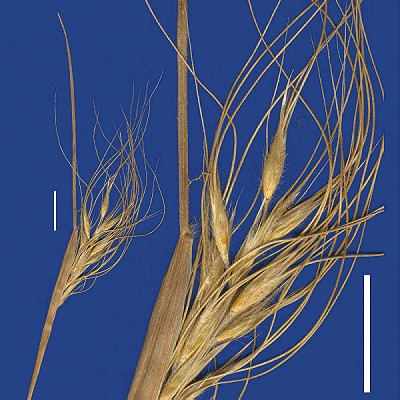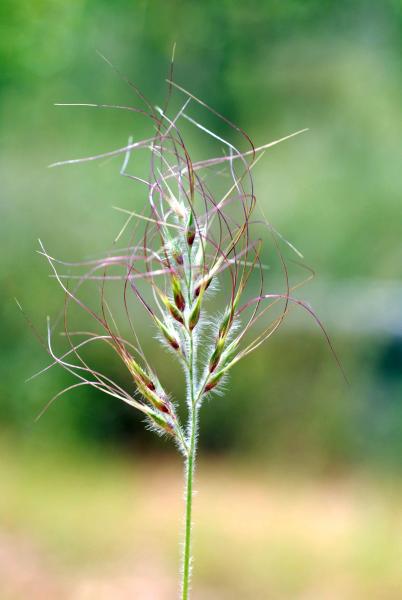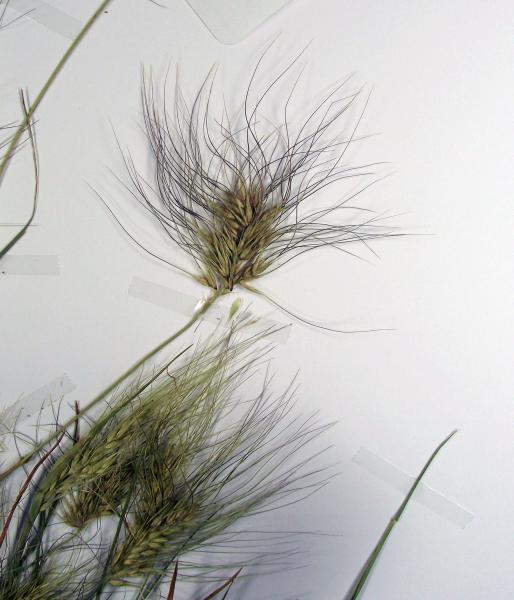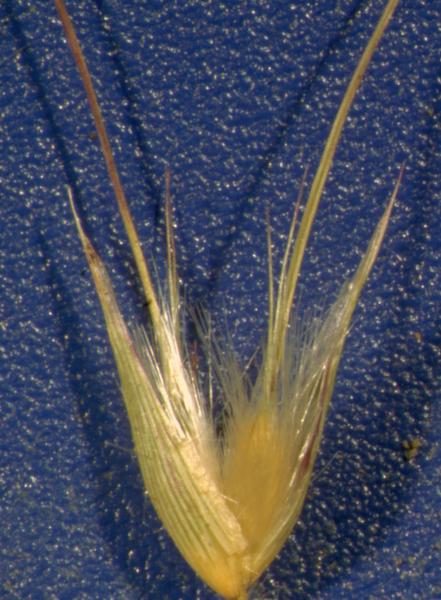Eriachne armitii F. Muell. ex Benth. Fl.
Austral. 7: 627 (1878).
Classification. (GPWG 2001) : Subfamily
Micrairoideae. Eriachneae.
Type of Basionym or
Protologue Information: LT: W.E.D.M. Armit 514, 1876, Australia:
Queensland: Cook District: Gilbert River (K; ILT: A, MEL-95273, US). LT
designated by Lazarides, Austral. Syst. Bot. 8: 366 (1995).
Key references
(books and floras): [1878] G.Bentham, Flora Australiensis 7 (627),
[1969] E.E.Henty, Manual Grasses New Guinea (97), [1981]
M.Lazarides in J.Jessop (ed)., Flora of Central Australia (442), [2002]
D.Sharp & B.K.Simon, AusGrass, Grasses of Australia.
Habit. Annual
or perennial. Culms erect or geniculately ascending, 5–50 cm tall, 2–3 -noded. Mid-culm
nodes bearded. Lateral branches simple or branched. Leaf-sheaths glabrous on
surface or hairy. Ligule a fringe of hairs. Leaf-blades 2–6 mm wide. Leaf-blade
surface scabrous, indumented.
Inflorescence.
Inflorescence compound, a panicle. Panicle oblong or ovate, 1.5–7 cm long,
0.8–5 cm wide.
Spikelets.
Spikelets pedicelled. Fertile spikelets 2-flowered, both fertile, comprising 2
fertile floret(s), without rachilla extension, ovate, laterally compressed,
8.75–11 mm long.
Glumes.
Glumes similar, thinner than fertile lemma. Lower glume lanceolate, membranous,
without keels, 9–11 -nerved. Lower glume surface glabrous or indumented. Lower
glume apex muticous or mucronate. Upper glume lanceolate, 8.75–11 mm long,
membranous, without keels, 9–11 -nerved. Upper glume surface glabrous or
indumented. Upper glume apex muticous or mucronate.
Florets.
Fertile lemma 2.5–4 mm long, without keel, 5 -nerved. Lemma surface indumented.
Lemma apex awned, 1 -awned. Median (principal) awn 15–45 mm long overall. Palea
apex lobed, awned (2). Grain 1.5–2.5 mm long.
Continental
Distribution: Australasia.
Australian
Distribution: Western Australia, Northern Territory, Queensland.
Western Australia:
Hall. Northern Territory: Darwin & Gulf, Victoria River, Barkly
Tableland, Central Australia North. Queensland: Burke, Cook, Gregory
North, Mitchell, North Kennedy, South Kennedy, Gregory South.
Notes.
Distinguishing characters include the annual ascending habit, dense often
partly exserted panicles with hispid or villous peduncle, axis, branches and
pedicels, acuminate sometimes aristulate usually partly glabrous glumes, short
florets relative to the glumes, long-awned lemmas entirely obscured by hairs,
and beaked biaristulate paleas. Panicles are produced thoughout the plant from
its base on sometimes short, axillary branches. The lemma lacks the submarginal
grooves, which characterise many species in the genus, but may have a
depression at its apex on both sides of the awn. Characters distinguishing E.
armitii from the closely allied E. stipacea are given under the
latter species. E. armitii has been confused with E. squarrosa,
which is a perennial with erect usually coarser habit, a denser indumentum on
the glumes, and lacks axillary panicles.
Endemic. The species
is distributed N of the Tropic of Capricorn; known in W.A. only by P.K.Latz
4010. Recorded habitats include deep or skeletal, clayey, loamy and sandy
soils over quartzite, granite or laterite, which are sometimes saline or
gravelly; also seasonally wet sites near swamps, salt pans, lakes and
watercourses, and disturbed ground. Flowers and fruits Feb.-June (late-summer
to early winter).








